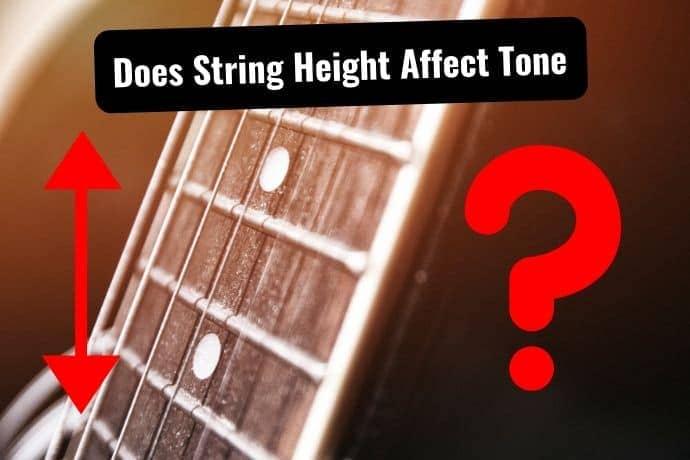
Ever wondered if the action of your guitar affects and alters your guitar’s tone?
With my experience of adjusting and tweaking my guitars for my personal tastes and playing style. This article will answer everything you need to know.
So let’s get to it…
Does the action/string height really affect your guitar’s tone?
Guitar string height certainly affects your guitar tone. A higher action allows for additional resonance and sustain than a lower action. However, a lower action that performs better when it comes to optimal playability. Find the right balance between playability and tone for your guitar playing style.
When referring to guitar string action, we’re thinking of string height.
This refers to the distance between the instrument’s strings and the fretboard. The “right” height usually comes down to personal preferences and a few different uses.
For instance, lower action is very popular among technical players, especially in metal and neo-classical music.
With the strings closer to the fretboard, you need less effort to press on the strings. This is especially useful for hammer-ons, pull-offs, and tapping.
Meanwhile, more or less higher action is usually pretty popular among blues guitar players. While it requires more effort to press on the strings, it gives more sustain and more room for using the slide technique.
However, guitar players might wonder whether action affects the tone. Yes, it most certainly does. We’re here to clear things up for you and help you understand how it does.
Low Action Guitar Tone
We’ll start with the low string action. Like we already mentioned, when the strings are closer to the fretboard,
it’s usually easier to press on the strings. This means you need to apply less effort, and your fretting hand will potentially suffer less strain.
At the same time, low string action can add, or remove, a few things in your overall output.
The first thing that you’ll be able to notice is less sustain. Any note you’ll play will usually last shorter with this kind of setting.
How Does it Sound?
At the same time, it will also sound less “open.” More problems occur when a string oscillates and hits on one or more frets on your guitar. It’s not uncommon to get that annoying fret buzz when lowering the string action.
All of this, of course, depends on the type of guitar that you’re playing. Cheaper instruments usually tend to have more fret buzz with lower string action.
No matter how you set them up, there will most likely be some buzzing in different areas of the fretboard.
After all, guitar factories and builders use cheaper materials and more cost-friendly methods in making these budget instruments.
With high-end guitars, you’ll have an easier time getting a good tone even with lower string action. However, setup can still be a little complicated, depending on the type of guitar you have.
On the other hand, some high-end guitars might be designed to work better with higher string action and just wouldn’t sound as good with low action.
This is usually the case with some Gibsons and other guitars you often see in the hands of blues players.
High Guitar Action Tone
As opposed to low string action, higher action does the opposite. First off, we can usually notice more sustain when the string action is higher.
In most of the cases, this is exactly the reason why some of the guitar players prefer higher action.
At the same time, we get more “openness” to the tone, making each individual note sound less suffocated.
For instance, a guitar player like Stevie Ray Vaughan preferred higher action. This way, he could let the note ring out and add some sustain to his Stratocasters that had single-coil pickups.
Reducing “Fret buzz”
Of course, there’s also significantly less chance to have fret buzz with higher action. Setting up your guitar this way just makes it harder for the string to hit other frets.
Having slightly higher action is really important with acoustic guitars. As string gauges can be a bit thicker with acoustics, you need more room for the note to ring out and be loud enough.
One of the most famous uses of higher string action is for the slide technique. In case you’re planning to become a great slide guitarist, you’ll probably want to go with higher string action.
With lower action, it becomes extremely difficult to play slide without hitting the frets.
The more distance between the strings and the fretboard and guitars will have more room for the note to ring out, which is really important for the slide technique.
This way, the player can slide over a string and keep the tone going for longer periods after picking only once.
High Action vs Low Action Comparison Video
Does Guitar String Height Affect Intonation?
One of the things we need to think about here is intonation. A string instrument like a guitar is way more delicate than one might think.
Despite being able to achieve those chugging distorted tones, there’s a lot of nuances and factors in the process of making even one note. Just like with tone, string height also affects the guitar’s intonation.
The whole process of intonating your guitar might be a little tricky.
There are some basic rules depending on the type of bridge your guitar has, but you’ll always have some trouble setting up the intonation with the desired string height.
It’s usually recommended to take your guitar to a qualified and experienced luthier or a guitar tech.
The most common thing you’ll notice is that higher action will usually mess with the intonation more.
However, in order to make noticeable changes in the pitch, the string would need to be extremely high, or extremely low. In most of the standard settings, you won’t notice much of a difference.
Do Guitar Actions Change Over Time?
To put it simply – yes, guitar actions do change over time. Any type of guitar bridge is a complex set of adjustable and moving parts.
In some cases of longer use, like a decade or more, it’s often recommended to replace saddles and even entire bridges. Things can get rusty or just too loose and unstable for normal operation.
There are many factors that can make an impact on your guitar’s action over time, including humidity and string tension.
So even if you leave your guitar just to sit around, it will change its action, and you’ll need to set it up and intonate it after a while. Of course, the more you play it, the higher the chances are that the action will change.
In addition, bridge components like saddles wear out over time, and the string indent can get deeper, ultimately messing with your action.
On the other hand, the string tension will tend to raise your instrument’s action over time.
This can get a little complicated with acoustic guitars. There are no bridges that you can set up, so you’ll probably want to replace the bridge or some of the components as they wear out.
What to Do if Guitar Action Keeps Changing
While it’s not uncommon at all for guitars to change action over time, things can get pretty annoying when the action keeps changing.
Just imagine – it takes you an hour or so to set everything up, and after a few days, your string action changes. And even though you set it up once again, it seems that the same things keep happening over and over again.
In these cases, the best idea is to take it to a luthier and see what they tell you. However, if this keeps happening to your guitar, there’s a high chance that some of the bridge parts need replacement.
This is not much of an issue. However, if it turns out that the neck is warped or that you’re having issues with the truss rod, there will be some significantly more expensive adjustments and repairs.
You’ll need to see whether this is worth it and if it’s easier just to get a new guitar.
Related Questions
Does higher Action give better tone?
A higher action offers more ‘sustain’ and better ‘resonance’ than a lower action. However, lower action is generally better for playability as it requires less fretting pressure to fret notes and chords. You should find a sweet spot considering your ideal set up for your guitars.
Does guitar nut affect tone?
A guitar nut influences a guitar’s playability more than tone, such as tuning stability and guitar string height. However, a nut made from a dense material will transfer vibrations effectively to the top wood of the guitar producing better sustain and resonance.
Thanks For Reading
If you enjoyed this post you have to read my related article “Does Guitar String Brand Matter?”
Find out if premium brands are better than less popular brands when it comes to string tone and quality!

